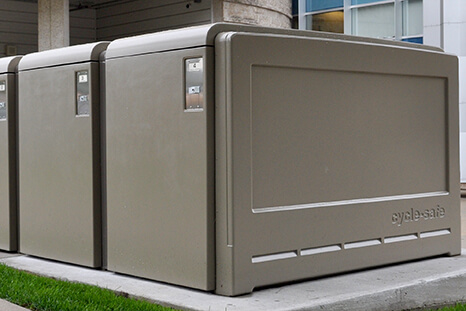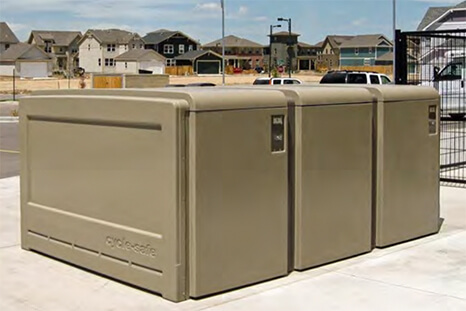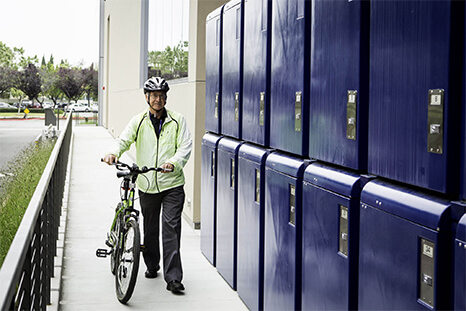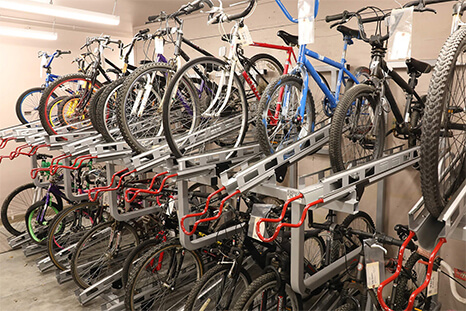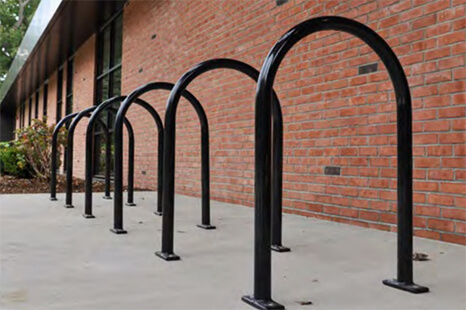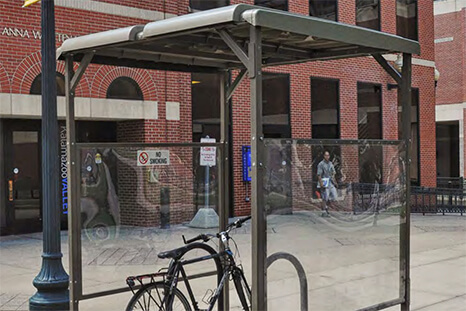Chicago, IL, Bike Parking Regulations and Standards
Chicago, Illinois, supports cycling as a sustainable mode of transportation by implementing robust bicycle parking regulations. These requirements aim to ensure that new developments and redevelopments provide both long-term and short-term bicycle parking facilities. The standards focus on security, convenience, and accessibility to encourage cycling across different neighborhoods and land-use types.
Long-term and Short-term Bike Parking Requirements
Long-term bicycle parking is intended for people who need to store their bicycles for extended periods, such as residents or employees. This type of parking must be secure, covered, and located within or near the building it serves.
Short-term parking, on the other hand, is intended for visitors and customers. It must be placed in easily accessible, visible locations, usually near building entrances, and must allow for quick, convenient parking.
Design Standards for Long-term Bicycle Parking
Long-term bicycle parking in Chicago must meet the following requirements:
- Must be located indoors or in covered, weather-protected areas.
- Should provide a secure locking mechanism for each bicycle, ensuring both the frame and wheels can be secured.
- Must offer a minimum space of 2 feet in width and 6 feet in length for each bike, with at least 7 feet of vertical clearance.
Design Standards for Short-term Bicycle Parking
Short-term bicycle parking in Chicago requires the following:
- Racks must be sturdy, allowing both the frame and at least one wheel to be securely locked to the rack.
- The minimum dimensions are 2 feet in width and 6 feet in length, with at least 7 feet of vertical clearance.
- Should be placed near building entrances, ideally within 50 feet of the main entry, ensuring easy access for visitors.
Placement Standards for Short-term Bike Racks
Bike racks should only be installed on the curb side of the sidewalk, where other street furniture (signs, newspaper boxes, light poles, street trees, etc.) is located, not the building side. Otherwise, parked bikes could force pedestrians to walk close to the street, which discourages foot traffic. Also, the presence of other street furniture provides a buffer—pedestrians are less likely to accidentally walk into racks placed on the curb side.
Other bike rack placement guidelines for Chicago include:
- 10’ minimum sidewalk width on most sidewalks. Exceptions may be made in areas with low foot traffic. Follow these guidelines:
- If sidewalk is no greater than 10’, site bike racks parallel to curb.
- If sidewalk is greater than 10’, bike racks can be sited either parallel or perpendicular to curb. Perpendicular is preferred because it allows more bike racks to be installed in the same space.
- at least 7’ of clear sidewalk
- at least 40′, preferably 45′, back from bus stop signs
- at least 4′ from general utilities, including fire hydrants and sewer covers • at least 3′ from curb, fence or wall
- at least 2′ from outside edge of tree planter basins
- at least 5″ from sidewalk cracks
- at least 6’ from subway emergency exits/hatches (hatches in sidewalk are large metal plates that open on the side, opposite the text “subway exit – keep clear”)
- at least 3’ from newsracks and newspaper boxes – avoid siting where two or more stand because more may appear in the near future, blocking access to the rack.
- at least 4’ from ramps, curb cuts, or crosswalk flares
- To avoid conflicts with future or not-yet-installed sidewalk cafes, site a bike rack outside of the property line of any business with a “Retail Food Establishment License;” such businesses may be eligible for a sidewalk café, resulting in the removal of the bike racks later. For an existing sidewalk cafe, site at least 6’ outside the edge of the sidewalk cafe.
- When siting bike racks near corners, follow these guidelines:
- In the direction of travel, on the near side of a corner, bike racks should be sited 20’ away from the intersecting curb.
- In the direction of travel, on the far side of a corner, bike racks should be sited 10’ away from the intersecting curb.
Off-Street Parking: Neighborhood Zoning Districts
Chicago Municipal Zoning Ordinances Bike Parking requirements are based on the number of minimum automobile parking ratios for each use group and District.
| Use Group | District | Minimum Auto Parking Ratio | Bicycle Parking Space Minimums |
|---|---|---|---|
| Group C: Multi-Unit Residential, non-government subsidized | B, C dash 5 | 1 space per unit for first 100 units; 0.60 spaces per unit for all additional units | 1 per 2 auto spaces in buildings containing 8 or more units |
| Group C: Multi-Unit Residential, non-government subsidized | R (All), B, C dash 1, 1.5, 2, 3 | 1 space per unit | 1 per 2 auto spaces in buildings containing 8 or more units |
| Group F: Universities, Day Care, Schools | R (All), B, C, M dash 1, 1.5, 2, 3 | 1 per 3 employees + additional parking and drop-off spaces as determined by Department of Zoning and Land Use Planning | 1 per 10 auto spaces; minimum 4 spaces |
| Group G: Hospitals | R (All) B, C, M dash 1, 1.5, 2, 3 | 1 space per 3 beds + 1 per 3 employees + 1 per doctor | 1 per 10 auto spaces |
| B, C, M dash 5 | None for first 35,000 square feet or 2 × lot area, whichever is greater, then 1.33 spaces per 1,000 square feet | 1 per 10 auto spaces | |
| Group L: Office | B, C, M dash 1, 1.5, 2 | None for first 4,000 square feet then 2 spaces per 1,000 square feet | 1 per 10 auto spaces |
| Group L: Office | B, C, M dash 3 | None for first 10,000 square feet then 2 spaces per 1,000 square feet | 1 per 10 auto spaces |
| Group L: Office | B, C, M dash 5 | None for first 35,000 square feet or 2 × lot area, whichever is greater, then 1.33 spaces per 1,000 square feet | 1 per 10 auto spaces |
| Group M: Retail, Eating Establishments | B, C, M dash 1, 1.5, 2 | Health Clubs: as required by Sec. 4-6-020 of the Municipal Code Participant Sports and Recreation: 1 per 10 persons capacity All other: None for first 4,000 square feet then 2.5 spaces per 1,000 square feet | 1 per 5 auto spaces |
| Group M: Retail, Eating Establishments | B, C, M dash 3 | Health Clubs: as required by Sec. 4-6-020 of the Municipal Code Participant Sports and Recreation: 1 per 10 persons capacity. All other: None for first 10,000 square feet then 2.5 spaces per 1,000 square feet | 1 per 5 auto spaces |
| Group M: Retail, Eating Establishments | B, C, M dash 5 | Health Clubs: as required by Sec. 4-6-020 of the Municipal Code Participant Sports and Recreation: 1 per 10 persons capacity. All other: None for first 35,000 square feet or 2 × lot area, whichever is greater, then 1.33 spaces per 1,000 square feet | 1 per 5 auto spaces |
Off-Street Parking: Downtown Zoning Districts (all districts)
| Use Category | Bicycle Parking Space Minimums |
|---|---|
| Multi-Family Residential | 1 per 2 required auto spaces in buildings containing 8 or more units |
Residential buildings within 2,640 feet of a CTA or METRA rail station entrance or exit or within 1,320 feet of a CTA bus line corridor roadway segment must contain at least one bicycle parking space per dwelling unit. Non-residential buildings within 2,640 feet of a CTA or METRA rail station entrance or exit or within 1,320 feet of a CTA bus line corridor roadway segment must contain at least one bicycle parking space for each automobile parking space that would otherwise be required under the applicable standards of Section 17-10-0200.
The above information represents a partial list of the facility types and their bike parking requirements for Chicago, IL. Please refer to the links below for more detailed information.
Showers and Personal Lockers
Employers and developers are encouraged to provide facilities such as showers and personal lockers, particularly in commercial and mixed-use developments. While showers are not mandated by Chicago regulations, they are strongly recommended for long-term bicycle parking in employment-heavy areas to encourage cycling as a commuting option.
Additional Requirements by Region or Neighborhood
In transit-served areas of Chicago, such as those near CTA or Metra stations, the city may reduce or eliminate minimum automobile parking requirements, allowing for increased bicycle parking. Bicycle parking in these areas is prioritized to encourage cycling as an alternative to driving.
Sources for Official Regulations
The official regulations for bicycle parking in Chicago can be found in the following documents:
CDOT Bike Parking Program Minimum Requirements: Placement Guidelines
CDOT Bike Corral Program Brochure
Chicago Zoning Ordinance for Parking and Loading

